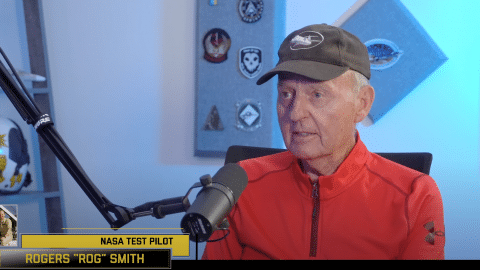
YouTube / Fighter Pilot Podcast
Rogers E. Smith had quite a career as a test pilot associated with NASA. As a research pilot, he specialized in advanced flight control systems, stability and controls, and flying characteristics. Smith has had his hands full with several iconic US aircraft, such as the F-18, F-15 ACTIVE, X-22A V/STOL, X-29 Forward Swept Wing, and the SR-71 Blackbird.
In the Fighter Pilot Podcast, Smith was more than happy enough to give us a few insights about the SR-71 when it returned to NASA in the mid-1990s. Here are a few of interesting tidbits from the podcast:
“Like a month. We had a simulator so they could study the systems and learn procedures. But they made sure you were ready.”
The Blackbird’s simulator was designed and built between 1963 and 1965 and is the only one ever produced. It was upgraded in 1989 and was shipped to the Dryden Flight Research Center to train NASA crews when they reinstated SR-71 operations from 1994 to 1997.
“We had two A models sitting on our ramp.”
According to Smith, they were lucky to have a crew proficient at maintaining the Blackbird. They would fly the SR-71s to Palmdale to get it re-inspected, then return them back to the Air Force afterward.
“They were testing their idea to take a vehicle, take off, and fly it to space.”
NASA is known for its extensive aeronautics and space research programs. This is the reason why we had X-Planes – experimental planes designed to test technological barriers.
Through these programs, we were able to test the viability of the X-13 VTOL Vertijet, X-35 Joint Strike Fighters, X-44 MANTA, and many more.
“It’s an acronym for Linear Aerospike Rocket Engine.”
LASREs had eight thrust cells of an aerospike engine that were rotated 90 degrees and mounted on the back of the Blackbird, operating like a flying wind tunnel.
Meanwhile, Lockheed’s Skunk Works made a 15,000-lb canoe attached to the top of the Blackbird, containing gaseous hydrogen, helium, and instrumentation gear.
“We had a scale model of one slice of a LASRE mounted on a fin in between the two tails. The idea was to do a seven-second burn to demonstrate, for the first time in flight, a LASRE getting ignited.
We flew it, but we never ignited it.”
“They did go through with changing the flight and inlet controls to digital.”
But that was it. After Congress voted to allocate $100 million to reactivate three SR-71s in 1994, the last flight of the SR-71 was performed in October of 1999.